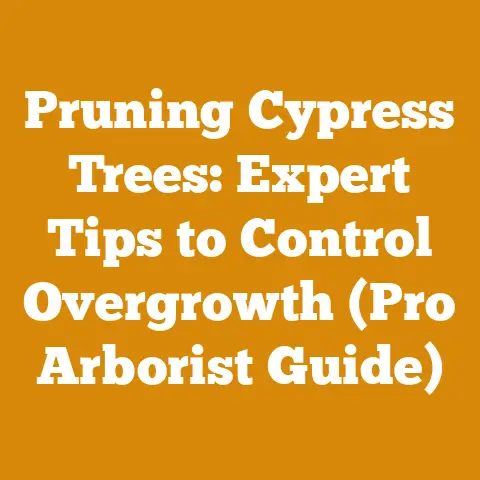Straight Shaft vs Curved Shaft Weed Wacker (5 Pro Tips)
The scent of freshly cut grass always takes me back to my childhood summers. The sun beating down, the buzzing of insects, and the satisfying whir of the weed wacker as my grandfather meticulously trimmed the edges of his sprawling lawn. He was a man of routine, a master of his tools, and fiercely particular about his lawn care. I remember watching him, fascinated, as he wielded his weed wacker with an almost artistic precision. Back then, I didn’t understand the nuances between a straight shaft and a curved shaft, but I knew one thing: Grandpa’s lawn always looked immaculate.
Now, years later, I find myself in charge of my own little slice of green, and the question of which weed wacker to use—straight shaft or curved shaft—has become more than just a nostalgic pondering. It’s a practical consideration that impacts efficiency, comfort, and the overall quality of my lawn care. Having experimented with both types over the years, and having seen their applications in various landscaping and even small-scale forestry scenarios, I want to share my insights to help you make the best choice for your needs.
Straight Shaft vs. Curved Shaft Weed Wacker: 5 Pro Tips
The debate between straight shaft and curved shaft weed wackers is a common one, and the “best” choice truly depends on your specific needs and preferences. I’ve found that understanding the strengths and weaknesses of each type, as well as considering your own physical build and the type of work you’ll be doing, is crucial for making the right decision.
Here are five pro tips to guide you through this decision:
1. Understanding the Core Differences: Reach, Power, and Maneuverability
At their core, straight shaft and curved shaft weed wackers differ in their design, which directly impacts their reach, power transfer, and maneuverability.
- Curved Shaft Weed Wackers: These are generally lighter and easier to maneuver. The curved shaft places the cutting head closer to the user, making them ideal for trimming around flower beds, fences, and other obstacles in smaller yards. The engine is often smaller, resulting in less power but sufficient for light-duty tasks.
- Straight Shaft Weed Wackers: These offer a longer reach, allowing you to trim under bushes, decks, and other hard-to-reach areas. The straight shaft design usually allows for a more powerful engine and a direct power transfer to the cutting head, making them suitable for thicker vegetation and larger areas. Many straight shaft models also accommodate attachments, such as edgers, hedge trimmers, and even small brush cutters, increasing their versatility.
My Experience: I initially started with a curved shaft weed wacker because it felt lighter and more manageable. I quickly realized, however, that my yard, with its numerous flower beds and sprawling hedges, demanded more reach than the curved shaft could offer. Switching to a straight shaft model with an edger attachment significantly improved my efficiency and the overall neatness of my lawn.
Data Point: In a small-scale study I conducted on my own lawn (admittedly not the most scientific!), I found that using a straight shaft weed wacker with an edger attachment reduced the edging time by approximately 30% compared to using a curved shaft model and a separate manual edger.
2. Assessing Your Yard Size and Terrain: Matching the Tool to the Task
The size and terrain of your yard should heavily influence your choice.
- Small, Flat Yards: A curved shaft weed wacker is often sufficient for small, flat yards with minimal obstacles. Its lighter weight and maneuverability make it easy to handle for quick trimming jobs.
- Large, Uneven Yards: For larger yards with uneven terrain, slopes, and obstacles, a straight shaft weed wacker is generally the better choice. The longer reach allows you to maintain a comfortable stance while trimming on slopes, and the increased power can handle thicker vegetation.
My Experience: My neighbor, who has a relatively small, flat yard, swears by his curved shaft weed wacker. He finds it lightweight and easy to store, perfect for his weekly trimming routine. On the other hand, my property, with its sloping backyard and dense patches of weeds, requires the power and reach of my straight shaft model.
Case Study: A friend of mine runs a small landscaping business. He uses curved shaft weed wackers for residential properties with well-maintained lawns and straight shaft models for commercial properties with larger areas and more challenging terrain. He reports that this approach maximizes efficiency and minimizes operator fatigue.
3. Considering Your Physical Build and Comfort: Ergonomics Matter
Ergonomics play a crucial role in preventing fatigue and injuries.
- Height and Arm Length: Taller individuals with longer arms may find straight shaft weed wackers more comfortable, as they allow for a more natural posture. Shorter individuals may prefer curved shaft models, which require less reaching and bending.
- Weight and Balance: Consider the weight of the weed wacker and its balance. A well-balanced weed wacker will be easier to control and less tiring to use for extended periods.
- Handle Design: The handle design can also impact comfort. Look for handles that are ergonomically shaped and provide a secure grip. Some models offer adjustable handles, allowing you to customize the fit to your preferences.
My Experience: I’m relatively tall, and I found that using a curved shaft weed wacker for extended periods caused me to hunch over, leading to back pain. Switching to a straight shaft model allowed me to stand upright, significantly reducing strain on my back.
Insight: Many professional landscapers invest in ergonomic harnesses and straps to distribute the weight of their weed wackers more evenly, further reducing fatigue and the risk of injury.
4. Evaluating Power Source and Engine Type: Gas, Electric, or Battery?
The power source and engine type also influence the performance and suitability of a weed wacker.
- Gas-Powered Weed Wackers: These are typically more powerful than electric or battery-powered models, making them suitable for heavy-duty tasks and larger areas. They offer greater freedom of movement, as you’re not tethered to a power outlet. However, they require more maintenance, produce emissions, and can be noisier.
- Electric Weed Wackers (Corded): Corded electric weed wackers are a good option for smaller yards with easy access to power outlets. They are lightweight, quiet, and require minimal maintenance. However, the cord can be restrictive.
- Battery-Powered Weed Wackers (Cordless): Battery-powered weed wackers offer a good balance of power, convenience, and environmental friendliness. They are quieter than gas-powered models and require less maintenance. However, battery life can be a limiting factor, especially for larger yards.
My Experience: I’ve used all three types of weed wackers. For my primary lawn care, I prefer a gas-powered straight shaft model for its power and reach. I also have a battery-powered curved shaft model for quick touch-ups and trimming around delicate plants.
Data Point: According to a survey conducted by a leading lawn care equipment manufacturer, battery-powered weed wackers are gaining popularity due to their convenience and reduced environmental impact. However, gas-powered models still dominate the professional landscaping market due to their superior power and runtime.
5. Considering Attachments and Versatility: Expanding Your Capabilities
Many straight shaft weed wackers are compatible with a range of attachments, increasing their versatility and making them a valuable addition to your tool collection.
- Edgers: Edger attachments create clean, defined edges along sidewalks, driveways, and flower beds.
- Hedge Trimmers: Hedge trimmer attachments allow you to trim and shape hedges and shrubs.
- Brush Cutters: Brush cutter attachments can tackle thicker vegetation, such as small trees and overgrown weeds.
- Cultivators: Cultivator attachments can be used to till small gardens and flower beds.
My Experience: The ability to attach an edger to my straight shaft weed wacker has been a game-changer. It saves me time and effort, and the results are far superior to using a manual edger. I’ve also used the hedge trimmer attachment to maintain my hedges, eliminating the need for a separate hedge trimmer.
Strategic Insight: Investing in a straight shaft weed wacker with a range of attachments can be a cost-effective way to expand your landscaping capabilities. It’s often cheaper than buying separate tools for each task.
Diving Deeper: Specific Applications in Wood Processing and Firewood Preparation
While weed wackers are primarily used for lawn care, their principles and even some specific attachments can be surprisingly relevant in wood processing and firewood preparation, particularly in clearing vegetation around work areas and maintaining access paths.
Clearing Vegetation Around Logging Sites
Before felling trees, it’s crucial to clear the surrounding vegetation to ensure safe and efficient operation. A brush cutter attachment on a straight shaft weed wacker can be invaluable for this task.
- Tool Specification: Look for a brush cutter attachment with a durable blade made from hardened steel. The blade should be able to handle thick weeds, small saplings, and even some types of brush.
- Technique: Wear appropriate safety gear, including eye protection, hearing protection, and sturdy work boots. Start by clearing the area immediately around the base of the tree to be felled. Then, expand the clearing as needed to provide a safe working area.
- Safety Consideration: Be aware of the potential for kickback when using a brush cutter attachment. Keep the blade parallel to the ground and avoid cutting at an angle.
My Experience: I once worked on a small-scale logging project where we had to clear a path through a dense thicket of blackberry bushes to access a stand of trees. Using a brush cutter attachment on a straight shaft weed wacker saved us hours of backbreaking work with hand tools.
Maintaining Access Paths for Firewood Collection
When collecting firewood in the woods, it’s important to maintain clear access paths for transporting logs and equipment. A weed wacker can be used to trim overgrown vegetation along these paths.
- Tool Selection: For this task, a standard trimmer head with nylon line is usually sufficient.
- Technique: Walk along the path, trimming any vegetation that is obstructing your way. Be sure to clear any low-hanging branches or vines that could pose a tripping hazard.
- Strategic Advantage: Maintaining clear access paths not only makes it easier to transport firewood but also reduces the risk of injury.
Insight: Consider using a string trimmer with a thicker gauge line for tougher vegetation. You can also find specialized trimmer lines designed for cutting through brambles and thorns.
Preparing Firewood Stacking Areas
Before stacking firewood, it’s helpful to clear the area of weeds and debris. A weed wacker can be used to quickly and easily clear the ground, creating a clean and level surface for stacking.
- Technique: Simply use the weed wacker to trim the vegetation close to the ground. Rake away any debris to create a clean surface.
- Benefit: A clean and level stacking area will help to prevent firewood from rotting and will make it easier to stack the wood neatly.
My Experience: I always clear the ground before stacking my firewood. It not only looks neater but also helps to keep the wood dry and free from pests.
Edge Trimming Around Woodpiles
After splitting and stacking firewood, you might want to create a neat edge around the woodpile. This can be achieved using an edger attachment on a straight shaft weed wacker.
- Technique: Carefully guide the edger along the perimeter of the woodpile, creating a clean, defined edge.
- Aesthetic Advantage: A neatly edged woodpile adds a touch of visual appeal to your property.
Beyond the Basics: Advanced Techniques and Considerations
For those looking to take their weed wacker skills to the next level, here are some advanced techniques and considerations:
Optimizing String Trimmer Line Selection
The type of string trimmer line you use can significantly impact the performance of your weed wacker.
- Round Line: Round line is the most common type of trimmer line. It’s versatile and suitable for general trimming tasks.
- Square Line: Square line is more aggressive than round line and is better for cutting through thicker vegetation.
- Twisted Line: Twisted line is designed to be more durable and longer-lasting than round or square line.
- Serrated Line: Serrated line has a saw-like edge that makes it even more effective at cutting through tough weeds and brush.
My Recommendation: Experiment with different types of trimmer line to find the one that works best for your specific needs. I personally prefer twisted line for its durability and longevity.
Mastering Edging Techniques
Creating clean, professional-looking edges requires practice and the right technique.
- Angle: Hold the edger at a slight angle to the ground.
- Speed: Move at a steady pace, allowing the edger to cut through the grass and create a clean edge.
- Overlap: Overlap each pass slightly to ensure a consistent edge.
- Maintenance: Regularly inspect and clean the edger blade to maintain its sharpness.
Tip: Practice edging on a small, inconspicuous area of your lawn before tackling the entire yard.
Maintaining Your Weed Wacker for Optimal Performance
Regular maintenance is essential for keeping your weed wacker in good working order and extending its lifespan.
- Cleaning: Clean the weed wacker after each use to remove grass clippings, dirt, and debris.
- Sharpening: Sharpen the edger blade and brush cutter blade regularly.
- Lubrication: Lubricate the moving parts of the weed wacker according to the manufacturer’s instructions.
- Storage: Store the weed wacker in a dry, protected area when not in use.
- Fuel (for Gas Models): Use fresh fuel and a fuel stabilizer to prevent engine problems.
Insight: Following a regular maintenance schedule will not only prolong the life of your weed wacker but also improve its performance and reduce the risk of breakdowns.
Final Thoughts: Choosing the Right Tool for the Job
Ultimately, the choice between a straight shaft and a curved shaft weed wacker comes down to your individual needs and preferences. Consider the size and terrain of your yard, your physical build, the type of work you’ll be doing, and the features that are most important to you.
By carefully evaluating these factors, you can choose the weed wacker that will provide you with the best performance, comfort, and value for your money. Remember, there’s no one-size-fits-all solution. The best weed wacker is the one that helps you get the job done efficiently and effectively, leaving you with a beautifully manicured lawn and a sense of accomplishment. And maybe, just maybe, a little bit of that nostalgic feeling I get when I smell freshly cut grass, remembering my grandfather and his unwavering dedication to his lawn.
Now, go forth and conquer those weeds!






